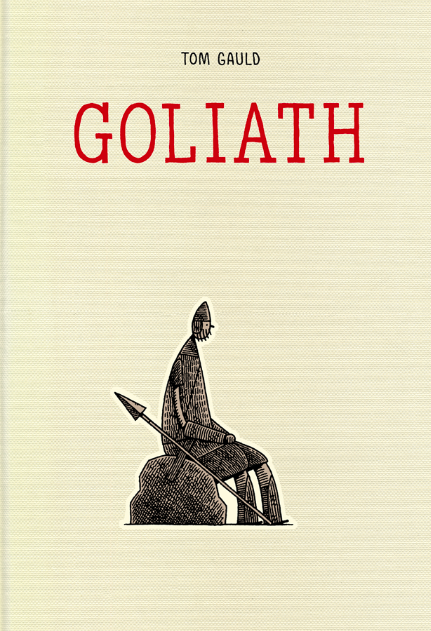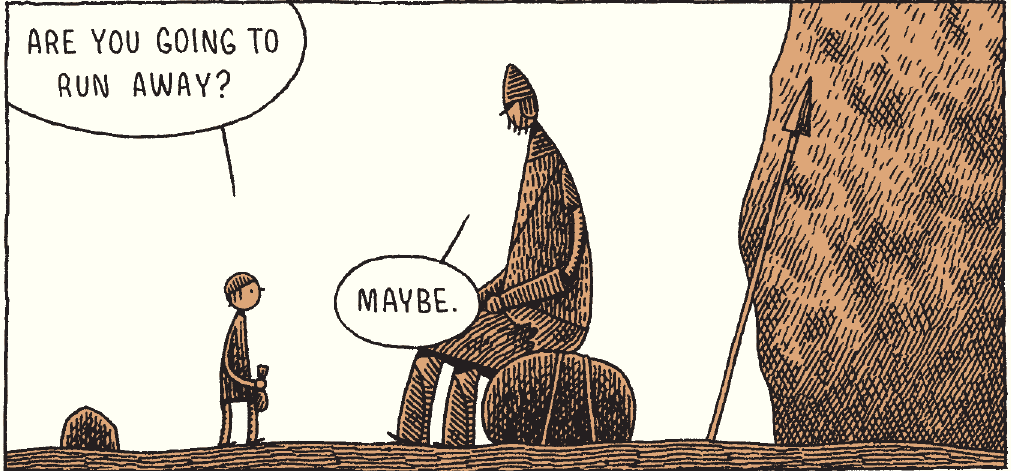Welcome to Comics Are My Religion, a look at theology through the lens of comic books. There are some basic ground rules about engaging in respectful dialog about religion in this column. There be spoilers ahead, so beware!
 Judas Iscariot. King Nebuchadnezzar. Pharaoh. Jezebel. The Serpent. These are among some of the wickedest villains in the entire Christian Bible. But one villain literally stands head and shoulders above them all.
Judas Iscariot. King Nebuchadnezzar. Pharaoh. Jezebel. The Serpent. These are among some of the wickedest villains in the entire Christian Bible. But one villain literally stands head and shoulders above them all.
Goliath.
The gigantic Philistine warrior has been depicted in many ways over the years, most of which have him towering over the young boy David. He is usually rugged and burly, with sword and spear in hand, ready to take down any challenge that comes his way. The story of the epic battle between Goliath and David has been the epitome of the underdog’s tale, and has been recreated across all types of media. Even the name “Goliath” has now become synonymous with a hulking, huge giant.
We all know the story, even if you haven’t read the Bible. In the first book of Samuel, we are introduced to the young boy David who is chosen to be king of Israel, even though Saul is already king. The Israelites are at war with the Philistines, and in order to prove his faith in God and his own bravery, David goes out to fight the mighty Goliath, who stands out and daily beckons the Israelites to send a warrior out for him to fight. We all know what happens in the end, as Goliath ends up “losing his head.”
But what if we looked at this story from Goliath’s point-of-view? In an earlier Comics Are My Religion, I covered A. David Lewis’ The Lone and Level Sands, which took the Pharaoh’s perspective of the Exodus story, so you know I am a sucker for a different take on a classic story.
Tom Gauld gives us a humorous and poignant look at the story through the big man’s eyes in his Goliath hardcover, which came out in comic shops on February 22, 2012 from Drawn and Quarterly Books.
 Gauld’s Goliath is no hulking warrior. Sure, he’s tall and he has a beard, but he prefers administrative work rather than fighting. Goliath is peaceful and rather innocent, and is loyal to a fault. It’s this loyalty to his king that gets him sent to the front lines as a psychological attack against the Israelites, whom we never really see. In a rather funny turn of events, Goliath calls out the Israelites day and night with a script in his hands, and is nowhere near the frightful soldier that 1 Samuel depicts. In fact, it makes the end of the story that much sadder when this sympathetic Goliath meets the diminutive David out of the mist.
Gauld’s Goliath is no hulking warrior. Sure, he’s tall and he has a beard, but he prefers administrative work rather than fighting. Goliath is peaceful and rather innocent, and is loyal to a fault. It’s this loyalty to his king that gets him sent to the front lines as a psychological attack against the Israelites, whom we never really see. In a rather funny turn of events, Goliath calls out the Israelites day and night with a script in his hands, and is nowhere near the frightful soldier that 1 Samuel depicts. In fact, it makes the end of the story that much sadder when this sympathetic Goliath meets the diminutive David out of the mist.
Gauld makes a lot of choices in his telling of this story, but never really contradicts the original tale, and that shows Gauld’s creativity. The only piece of the 1 Samuel story that he omits is Goliath’s taunting of David just before their battle. Anyone could tell a story about Goliath’s side of the story, but to stay true to the original text, and yet make this classic villain a sympathetic character is impressive. There are few characters in the story at all, and many of the panels have Goliath and his shield-bearer, another young boy who mirrors the character of David, standing and talking amidst a barren and desolate background. There is a loneliness to Goliath and his story, which makes the reader want to grab him up and save him from his impending doom. Because of the reversal of Goliath’s character, the approach to this story is completely different and original.
The tone of the book felt like one of those independent short films where the characters are crudely drawn, the pace feels slow and dry, but the message is poignant. Gauld’s art is rudimentary, with his figures looking like children’s drawings. However, the simplicity with which Gauld draws this book does not relate to the techniques of storytelling that he uses from page to page. Many say that less is more, and with Gauld’s art that is truly the case. There is an innocence to his pencils, but cast with the brown palette of the book, there is a somberness that draws the reader. Such a child-like style is not usually up my alley, but paired with Gauld’s knowledge of how to tell a visual story, I find myself captivated.
 The book is not without a dry, quiet sense of humor. The Philistines pass the time by pitting bears against lions, dogs, and even people. One soldier casually asks Goliath if he wants a shot at the bear, which is done really well. Another funny moment happens when Goliath is fitted with armor, but pieces continually fall off the armor as he makes his way to his “station.”
The book is not without a dry, quiet sense of humor. The Philistines pass the time by pitting bears against lions, dogs, and even people. One soldier casually asks Goliath if he wants a shot at the bear, which is done really well. Another funny moment happens when Goliath is fitted with armor, but pieces continually fall off the armor as he makes his way to his “station.”
Goliath shows us once again that a story is all about point-of-view. What if Goliath had been put up to his task? What if he was chosen to frighten the Israelites because of his size, but was really a nice guy underneath all that armor and weapons? Gauld pushes these questions, and in fact, in the few pages that David shows up, he looks more like a religious zealot than the innocent boy who follows the call of the Lord. In reading the Hebrew Scriptures, it can be easy to assume that God is always on the side of the Israelites, God’s chosen people. But reading books like these makes you sympathize with these biblical “villains” and make you wonder if the violence was worth it at all.
I applaud Gauld for asking the question, and presenting a well-planned, humorous, and poignant book. Goliath is an example of what good storytelling can do, even with stories we’ve heard hundreds of times. Gauld shows us that even villains can be good guys.
Jeff Jackson
jeff@comicattack.net

This was the first thing I read this week, and thought it was simple and quick, but very endearing.
A great read for sure!
Sounds interesting, Jeff. So if the lesson in the Bible was “have faith in God/ heed God’s call and you can face and overcome any challenge”, what is the lesson/moral in Gauld’s book?
I think the lesson here is “just because a guy is big doesn’t mean he’s a giant warrior.”
Pingback: Chirpin’ Tuesday Reviews 2/22/2012